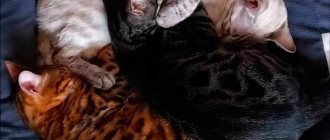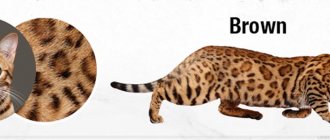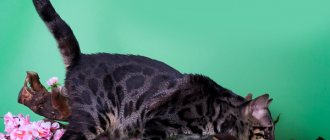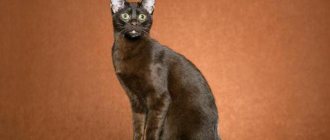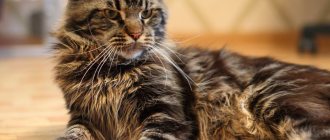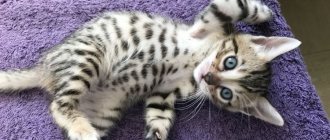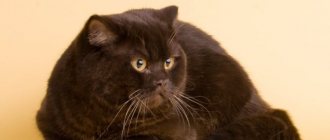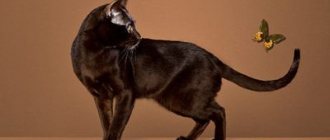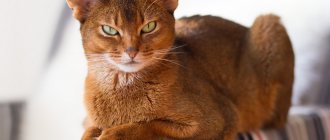Coat and color are a distinctive feature of the Bengal cat. Each pattern is individual: spots or stripes on a cat are like fingerprints on a person; no two are alike. Today, there are many colors of Bengal cats. The Snow Bengal stands out among all of them; it is even sometimes confused with another breed. Every cat lover dreams of having a little “leopard” at home.
Color standards
Outwardly, the Bengal cat always resembles its wild ancestors. On the muzzle there are contrasting dark stripes that resemble the letter “M” on the forehead. Light-colored whisker pads. The contours of the nose, lips and eyes are black or darker. Dark stripes on the neck, like a necklace, decorate it. There are often small stripes on the paws, but there may also be spots. The tail is also spotted or rosette, but its tip always remains black. All breeders strive to get as close as possible to the appearance of a wild cat. Therefore, the spotted belly and chest should preferably be lighter. It is not always possible to achieve such selective lightening - scientists still cannot definitively determine the gene that is responsible for this.
The colors of Bengals are distinguished by the color of the background and the type of pattern that is located on it. The most common are gold and silver backgrounds. There are snow bengals, among which there are lynx, mink, and sepia. The charcoal color is considered more rare. The blue color is also officially recognized.
History of the formation of the Bengal breed
In addition to the wild Asian leopard cats ALC, a whole list of breeds took part in the origins of the formation of Bengals - Abyssinian, American Domestic Shorthair, Egyptian Mau, Persians, Exotics, Ocicats, Burmese. The list contains only those that contain relevant documented breeding information. In fact, genes from other species of domestic cats may also be involved.
It is not surprising that the multi-color and multi-breed mix has resulted in an impressive metamorphosis from the original base color and pattern of the Brown Tabby hybrid. Little remains of the classic original requirement for phenotypes. The most consistent was the desire for black pads on the feet and the end of the tail of the same color. As a result of the altered regulation of the agouti complex in Bengals, a huge variation in the amount of eumelanin appeared in different lines. This gave different individuals a wide range of colors.
What genes “work” in the range of colors of the breed
The base pigment of Bengals remains black, but the coat colors themselves are visually perceived in a whole palette of reddish-reddish-golden shades. The color “hot cinnamon” (Hot Sorrel) in the main subspecies of the Brown Tabby color has a frequent appearance. But chocolate, cinnamon colors and their variations did not receive recognition - this place in standardization is the most incomprehensible, since not a single document contains recorded recommendations for registration (or refusal to register) these colors. That is, the carrier animals themselves participated in the breeding, the crossings were registered, but the colors from the black series that gave birth to them remained unrecognized. The main argument: they wanted to preserve the ALC color of the wild cat, which has more ruffisms (red shades).
About the genes of snow and blue Bengals
The series of silver colors were luckier. Although it is difficult to find out from representatives of which breed or breeds the inhibitor gene came to Bengal cats, experts admit that Bengal cats with silver in the main background of their coat are very impressive.
A large variety of coat colors in this breed was introduced by the recessive solid color gene C. The colors of Bengals contain all combinations of this gene (albinos should be excluded from the series). This is what the genes that came as a result of selection are responsible for:
— C – uniform color of the cover throughout the body;
— cb – “Burmese” gene, which introduced minor highlights throughout the body;
- cs - “Siamese” gives color only to the protruding parts of the body.
All colorways containing the C series are called Snow Bengals. Snow Bengals are divided into subgroups. Read a separate article about them, but let’s just say here that there are analogues of the Burmese, Tonkinese, and Siamese Links samples.
The subspecies responsible for the emergence of the still rare blue subspecies is also known as recessive. It is tolerated by any representative of the breed, and from the mating of a cat and a cat without a hint of blue fur, kittens that are smoky or bluish in color are born, although very rarely. Here with the definitions, although the coloring is officially recognized by several federations, not everything is clear either. Often, “blue cats” include diluted color forms of traditional brown shades.
About the white color in the color of Bengals
The “white belly” trait, coveted by breeders and inherent in wild cats, is difficult to inherit in Bengals. In an Asian leopard cat ALC, the areas occupied by light fur cannot be called white. The belly, lower part of the tail, and inner surfaces of the legs are warm cream or beige with the obligatory, albeit dim, spotted pattern. The breed does not have a white color, but rather a “presence effect” of it, for example, in the form of light “spectacles” around the eyes, on the chin, as well as in the groin and chest. Bengals have practically no white areas at all.
Experts suggest that white is inherited as recessive, like other color features of the breed. It has been established that when crossing a cat and a cat with almost white bellies, the offspring rarely inherit the trait.
This means that its transmission is more complex - it is controlled by several genes. The white color develops insidiously - it seemed to be present from 5 months to a year and a half, and then it changed color to beige. Professionals even know the term Whited Bengal, which is awarded to representatives of the breed who, to some extent, have retained their white tummy after two years of life.
Pattern: spotted or marbled
Cat coloring is divided into two types:
- Spotted (from English spotted) or rosette (from English rosetted) pattern. In the first case, these are solid spots. In the second, the so-called sockets. The color inside the rosette should be darker than the background, which is completely or partially surrounded by a darker circle (closed and open rosette). The size of the spots or rosettes can range from small to large.
- Marble (from English marbled) pattern: represents various horizontal stripes. Circular or vertical marks are faults. It is more highly valued when the marble pattern of the Bengal contains three colors: the background shade, the pattern and its edging.
To distinguish the colors of Bengal cats, it is easier to use the table:
Phasing in Bengal cat kittens
The thin, sparse, light-colored fluffy coat that appears in kittens immediately after birth is a natural defense in the wild. Bright spots can reveal a kitten of a forest animal to its predatory enemies. A unique means of camouflage in children is preserved in generations that are no longer hybrids. As kittens grow up, they get rid of the hairs that cover spots or stains. On a light base background, kittens have less phasing coat. By the age when kittens enter the young stage, their attractive “leopard” appears more clearly. There are known cases of reappearance of phasing fur if kittens were born with a camouflage coat. If the temporary hairs do not fall out, the Bengal kitten is rejected from among the purebreds.
The variety of colors of Bengals is understandable: this is a young breed that carries the genes not only of the Asian leopard cat, but also of a whole list of domestic breeds - American shorthair, Egyptian Mau, Abyssinian, etc. Each species brought its own genes, and in mixed matings this always gives amazing results . It will not be strange that in the future many of the currently non-standard Bengal colors will be recognized in felinology.
Considering that the fur of animals from this cat family usually has a beautiful shine, noticeable in sunlight, the attention of professional breeders and lovers of domestic tailed animals to the new breed is understandable. The variety of colors and patterns of Bengal cats is the result of the passionate and painstaking work of breeders who are constantly working to improve the standard, resulting in exotic, rare colors of Bengal cats and cats.
Snow Bengal
Snow color is one of the rare ones. Snow Bengal kittens are divided into three groups depending on their genotype.
Links (Ben n 33) The background is represented by shades of cream or ivory. The pattern varies in tones of brown from light to dark. The head and paws are darker than the body. The tail is brown. These are the only snow bengals that are born completely white, and the pattern does not appear until they are one year old.
Mink (Ben n 32) They are often confused with the link color. The drawing from birth practically merges with the background and is hardly noticeable. The main difference is the eyes: their color varies from bright green to blue.
Sepia (Ben n 31) The color is lighter than golden, but darker than other snow Bengal cats. The difference between the background and the picture is small. The pads on the paws are brown, as is the tip of the tail. Eye colors include variations of green and yellow.
Coat and colors of long-haired Bengals (Cashmere)
Initially, the gene for long hair was considered an undesirable trait in the breed, but at the moment long-haired Bengals (Kashmirs) are already recognized by some international felinological systems.
The legitimacy of distinguishing Kashmir cats from the total number of Bengal cats has become a goal of many catteries. Breeders in the United States were keen to have these cats recognized as a variety of the Bengal breed due to their long hair - perhaps this is why TICA calls the breed Bengal Longhair. European breeders are trying to give Cashmere cats the status of a new, separate breed. So far, the term “Kashmir” is not widely used and is used mainly among specialists. At the same time, such cats are becoming increasingly popular; there are already nurseries of this breed in the USA, Europe (Germany, Poland, England), and Russia. In 2022, the first system to recognize long-haired Bengals as a separate breed was TICA. Today, Cashmere cats can take part in championships in the TICA, WOC, CFA, WCF systems.
Wool texture
Cashmere Bengals are a natural variation, so one cannot yet expect a uniform coat structure and length from its representatives. The length can be like that of a Turkish Angora cat or like that of a Maine Coon. But, unlike them, Kashmiris have no or almost no undercoat; their wool is closer in quality to the hair of a Bengal cat than to the wool of other long-haired breeds. The hairs are very thin, smooth, soft, pleasant to the touch - like cashmere fiber. This is where the name of the breed comes from - cashmere, which is preferred by breeders. In general, the quality of Kashmiri wool is the same as that of short-haired Bengals, the only difference being the length. This coat is easy to care for. Some believe that Kashmiri wool sheds less and is even hypoallergenic. This topic has not yet been fully studied, but definitely the molting period in these cats is almost invisible.
Colors
Long-haired Bengals have all the same colors as short-haired ones, including even the charcoal group. However, the Kashmiri does not have glitter, and the glitter is in no way related to the length of the coat: the kitten inherits this trait from its parents. The breeder’s task in this case is to select the appropriate pair.
In pattern, Cashmere cats are as beautiful and varied as short-haired Bengals. Their coats can be spotted or rosetted, or marbled, with dark curls contrasting with their light, silky fur.
How to tell if a kitten is Kashmiri
As adults, Kashmiris and Bengals are easy to distinguish from each other, but in infancy this is not always easy. When a litter is born, it is difficult to say which of the kittens will become long-haired if among the parents there is at least one short-haired one who carries the long-haired trait. And even if both parents are Bengals and carry the recessive gene for long hair, it is difficult to predict what their kittens' coat will look like. Most often, in one litter there are kittens with different hair lengths. Typically, the first signs of long hair appear between 4 and 12 weeks of age: you may see “pants” on the hind legs or long hairs in the ears.
Mixed bengal cat
Bengals are prohibited from crossing with other cat breeds. This is fraught with sick or completely non-viable offspring. However, some engage in this activity for commercial purposes. Such kittens can be found through frequent advertisements on the Internet. We warn you! Mixed breeds of the Bengal cat are not officially recognized. Such kittens do not belong to the Bengal breed. As a result, you can get a kitten that will not meet external standards, but also its character. Breeders carefully select affectionate and non-aggressive representatives. Otherwise, the genes may take over and you will end up with an uncontrollable animal. Long-haired mixed breed (cashmere bengal, silk bengal) is gaining popularity. The animal has a similar color. It is distinguished by a fluffy tail, a “collar”, and longer hair on the sides and back.
About the famous sparkler glitter
From English glitter translates as shine, flicker, radiance. All these “sparkling” definitions are suitable in describing the effect on the surface of the coat, which was noticed and successfully fixed in Bengal cats. In sunlight, there is an impression that rays are reflected from the hairs, like from mirror needles. The peculiarity is not inherent in all representatives of the breed, and its origins are from a tailless (trampled by rhinoceroses) kitten named Delhi, brought from India by Gina Mill and became a pair of hybrid Bengal brides.
There are two explanations for the glitter effect at the hypothesis level. Several different assumptions interpret this phenomenon.
- The characteristic shine is controlled by a special recessive gene, which in its homozygous state leads to a certain grouping of pigment granules on the hairs. As a result, the texture of the wool does not change, and the surface of the hairs begins to reflect light.
- In another version, this gene, being in a homozygous state, thins out pigment granules. As a result, microscopic air bubbles are formed, which... catch rays by refracting light. Proponents of this hypothesis are confident that the same gene gives softness and silkiness to the hair. The glitter effect gives classic coat colors a golden shine, and light silver Bengals a pearly sheen.
What diseases do Bengal cats most often suffer from?
The average life expectancy of Bengals is 12–15 years. It depends on where the cat lives and is cared for.
Real Bengal cats have a strong body, but are still susceptible to some diseases. Most often they suffer from the following health problems:
- Food poisoning, indigestion, intestinal diseases. Bengals have a very sensitive stomach that reacts poorly to changes in food and poor quality nutrition. More often than usual, they suffer from inflammatory bowel diseases.
- Hypertrophic cardiomyopathy. This is a pathology of the structure of the heart when one of the walls is thicker than the others. The danger of this disease lies in the absence of early symptoms. It often does not manifest itself, so regular heart examinations: ultrasound and ECG are important for Bengal cats.
- Flat chest syndrome. This Bengal disease is unique to kittens. Due to a disorder in the structure of the chest, the ribs compress the chest cavity and interfere with normal breathing. As a rule, kittens with a severe stage of this syndrome die within the first days or weeks of life. If this does not happen, then the animal develops as expected.
- Poor functioning of the immune system. For such animals, regular vaccination and deworming (getting rid of worms) are especially important.
Like almost all cats, Bengals are prone to urolithiasis.
Prevention
To prevent the occurrence of diseases, you should adhere to the following rules:
- Use only fresh and high-quality food in the diet.
- Give the animal filtered or bottled water and fresh water, which must be changed at least twice a day.
- Regularly carry out antiparasitic control. The fact that an animal does not go outside is not a guarantee that it will not acquire parasites, since even a small flea carried on a person’s shoe can cause big problems. Therefore, once every three months it is necessary to carry out preventive measures against worms and, if necessary, treatment for fleas and ticks.
- Be sure to follow the vaccination schedule.
- Regular examination will help prevent or detect at an early stage almost all diseases. Therefore, a visit to the veterinary clinic must be done annually.
- If the cat is not planned to be used for procreation, then sterilization should be done.
- It is very important to constantly monitor the condition of the animal. If you think that something is wrong with your pet, then it is better to show it to the doctor once again.
To keep your animal healthy, you need to monitor its diet.
Classification Features
Experts today identify 3 main colors characteristic of this breed: brown (almost golden), silver and 3 more rich snow colors. Within any of these color shades, there are 2 generally recognized types of patterns: spots and marbling. There are special tables that can be used to easily determine the color of a Bengal and describe the characteristics of its color.
Any designation of the color of a cat’s fur has a number of groups.
- The name of the breed itself is 3 capital English letters.
- The name of the base color is 1 or 2 lowercase letters, while the second s means silver color, the second y means golden (n is the black color of the breed, ns is the black smoky color, ny is black with gold).
- The minor part of the current index will be specified if necessary and will consist of two numbers. The first is the type of the very trait that is being described, for example, the color of the eyes or the presence of white spots on the coat, and the second number characterizes the trait itself.
Many people identify the correct color of Bengals by number:
- From “0” – the presence of white coloring in the coat;
- C “1” – tipping size for the silver group of the breed;
- With “2” – the type of pattern of the tabby breed;
- With “3” – highlighting the type of color of the point group;
- C “5” – expression of tail length (if tail anomalies are present);
- With “6” is the eye color, it is indicated when the colors may differ.
Types of drawings
If, when breeding this breed, breeders strive to bring the appearance of cats as close as possible to the original (wild) one, then in terms of colors they have long conquered even nature itself. First of all, it is necessary to mention here those pets from whom the Bengal received all the best for its breed. Abyssinian cats allowed us to add warm tones of apricot to the background of the Bengal fur. Burmese cats have passed on their unique coloring called sepia.
The Siamese lightened the body, while leaving the bright points dark and much more contrasting. Mau from Egypt donated her silver and bronze color. American cats with short hair gave the breed a marbled color. The result was a surprisingly bright and beautiful cat.
The rarest colors
Blue and black bengals are not yet recognized by the International Feline Association, but due to their interesting colors, they are popular.
Melanistic
This is a black Bengal with a subtle pattern. Panthers wear coats of this color in nature. A newborn kitten has a standard patterned color, and the darkening of the fur of a melanistic Bengal is observed in adulthood.
Ash or charcoal color
This type of color belongs to the brown tabby, but is characterized by a cooler, lighter tone of the base background. The large pattern on the body and muzzle is jet black.
The cat's eyes are outlined with a light stripe, giving the impression that the animal is wearing glasses. The black color today does not have official recognition and is not included in the standard, although it is very popular among Bengals.
Blue
BEN a 24. Very rare coloring of a non-standard type. The color of the skin is grey-blue, with a slight peach tint in the chest area. The pattern is patterned, gray in color. Felinologists have recognized this color as official.
Other
There are Bengals of other original colors:
- solid black;
- solid chocolate;
- lilac;
- tortoiseshells.
But Bengal cats with such colors are rare and are considered defective: they have no exhibition value and are not used in breeding.
Common colors
Of the huge number of types of colors, nature gave these small wild predators only one - “black spotted tabby”, and it is ideal for high-quality camouflage in a wild environment. The coat can have colors from delicate sand and gray to the darkest chestnut - this depends on the cats’ habitat. At the same time, the process of hybridization brought its own changes to the Bengal breed, and very interesting varieties appeared in the standards.
The TICA standard distinguishes 5 different colors. All of them, according to genetics, are black in color, but due to the increased degree of rufism, the color of cats often looks like yellowish-brown, leopard. That's why these colors are called:
- brown spotted marble tabby;
- silver spotted marble tabby;
- seal sepia spotted marble tabby;
- seal mink spotted marble tabby;
- seal spotted marble lynx-point.
In all of the above colors, experts allow the 2 types of patterns described above. In addition, a number of standards take into account blue colors. In this case, there can be combinations of all 4 listed colors and 2 patterns with silver wool.
Sometimes breeders produce completely black cats (melanistic), chocolate-colored kittens, and even lilac cats with tortoiseshell colors.
But these colors are not yet considered correct, therefore such cats are not used for breeding.
It is the brown tabby that is considered the original variety of the modern Bengal breed. The wild cat Malaysia once had a similar color, which was crossed with the Abyssinian black cat. The spots and stains (and plain ones too) in their descendants can be completely black, with a transition to a dark chocolate shade, or brick-brown, and even with a yellowish-brown tint.
Unrecognized colors
In addition to the standard color of Bengals, there are new options that have not yet received recognition:
- Carbonic. The type resembles silver, but the base tone is much darker. The clearly defined black pattern has no blur and is clearly visible against a gray or ashy background. The general color palette is cold. The nose of the Charcoal Bengal is black, and there is a light edging around the eyes.
- Melanistic. The almost monochromatic black Bengal cat with a faintly visible pattern belongs to this color. A kitten is born with a normal contrasting pattern, which with age completely covers up the glitter. Occasionally, melanistic Bengals may be a different color.
- Blue. This color option is characterized by a less bright pattern of bluish-gray color with a metallic sheen. The pattern consists of large rosettes or spots. The background of the coat is bluish-gray on the back and soft peach on the belly. The Blue Bengal cat is extremely rare.
Care and feeding of Bengals
A short-haired cat brings less worries at home than its long-haired counterparts, which makes caring for your pet much easier. Keeping and caring for a cat is not difficult: 2-3 times a week, devote a little time to combing the fur, which a soft rubber brush will help with. Sometimes you may not even notice the shedding, but once the procedure has begun, it is better to comb the kitty more often.
The descendant of a wild leopard cat needs to trim its claws once every couple of weeks. The ears are cleaned at the same intervals with a damp cotton pad.
It is also necessary to take care of your pet's oral cavity by brushing its teeth once a week.
The bath easily becomes a favorite place for the Bengal, who happily hits the water with his paws. Washing is allowed in rare cases using special cat shampoos.
Feeding a Bengal kitten occurs from month to month according to the feeding schedule and recommendations of specialists. Good nutrition quickly turns a small cat into a healthy, strong cat.
What to feed a Bengal kitten for 2 months
They also feed raw meat (beef or rabbit), exclude raw offal from the diet, replacing them with boiled sea fish once a week. Dairy products in the form of kefir, baby cottage cheese without any additives, and low-fat cream are useful for cats. The daily food intake also involves the addition of vegetables not exceeding a quarter of the volume of meat products. These are carrots, tomatoes, bell peppers. A Bengal cat can be switched to premium and super premium dry food, which the animals eat with benefit and pleasure.
Keeping a neutered cat involves replacing natural nutrition with specialized food.
Castration and sterilization
In everyday life, these terms are used as referring exclusively to the female or male. It is important to understand the difference between these definitions. During castration, the reproductive organs of an animal are removed - testicles in males, ovaries without/with a uterus in females. During sterilization, the spermatic cords in males and the fallopian tubes in females are ligated.
Males begin puberty at approximately 7-9 months, so most veterinarians recommend spaying/neutering them at this age. Sometimes it is practiced to carry out this intervention at an even earlier age, at about 2-4 months. Western veterinarians claim that surgery at such an early age has no effect on the kitten’s growth.
Females can be spayed/neutered starting at 6 months. Most often, veterinarians recommend performing this operation at the age of 8–9 months, before the onset of estrus. At this age, cats recover better from anesthesia and recover faster after surgery.
How blue Bengals appear
The color gene responsible for the birth of a blue Bengal kitten is known as recessive. That is, it can be carried by any color, different types of patterns - a pair of Bengals without signs of blue in their fur may have smoky blue kittens. They will also recessively carry the “blue gene”, but it will not necessarily appear in the coming generations. However, in cases where a blue female is offered the same male for mating, the likelihood of the desired elite coloring in the offspring increases.
Breeders who have extensive experience working with blue Bengals have discovered an interesting pattern: when working with a recessive gene, other “non-major” genes often become dominant - for example, large spots, special softness of the coat, its shine. This is one of the reasons why Blue Bengals are quickly gaining popularity among professional breeders.
Unexpected results from the blue gene (blue is often considered a diluted color form of traditional brown shades) have given rise to a number of varieties. Experts already distinguish such types as spotted and marbled blue lynx, blue mink, blue sepia - spotted or marbled.
